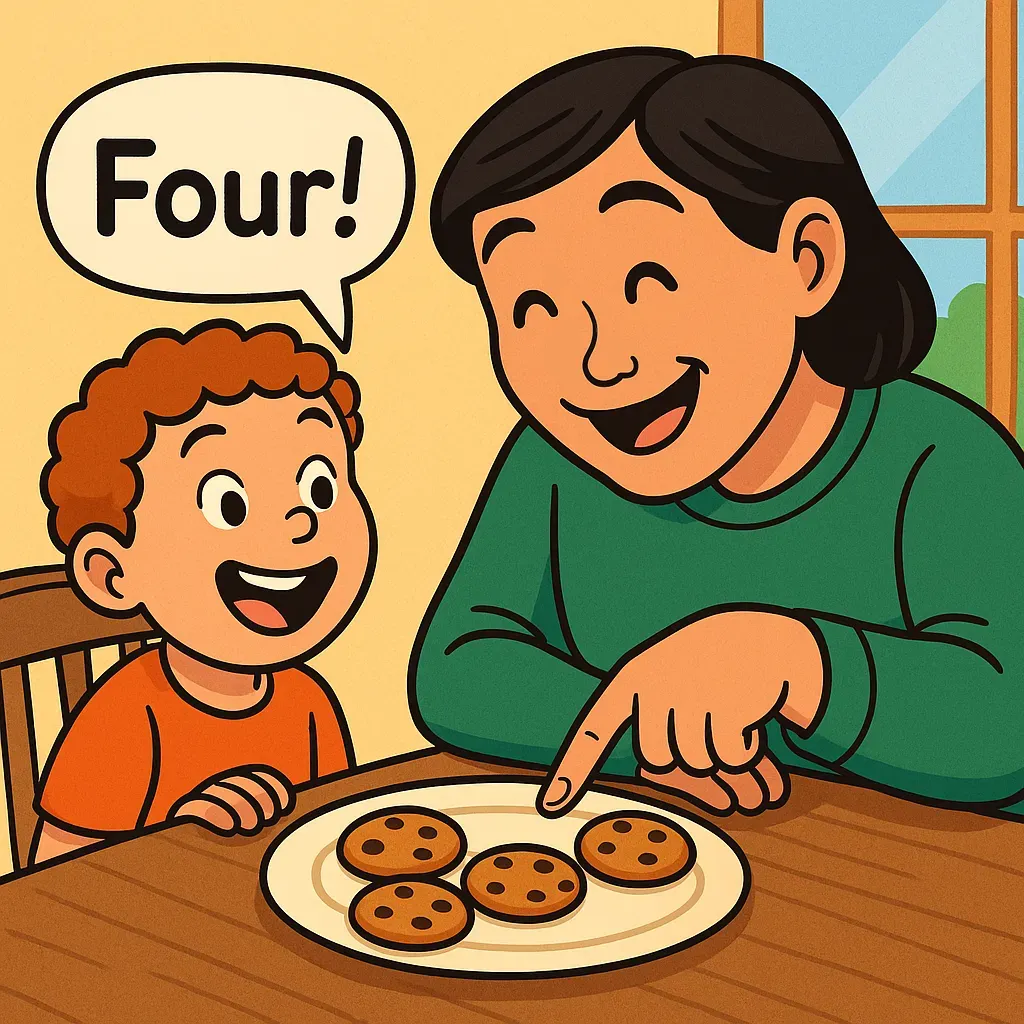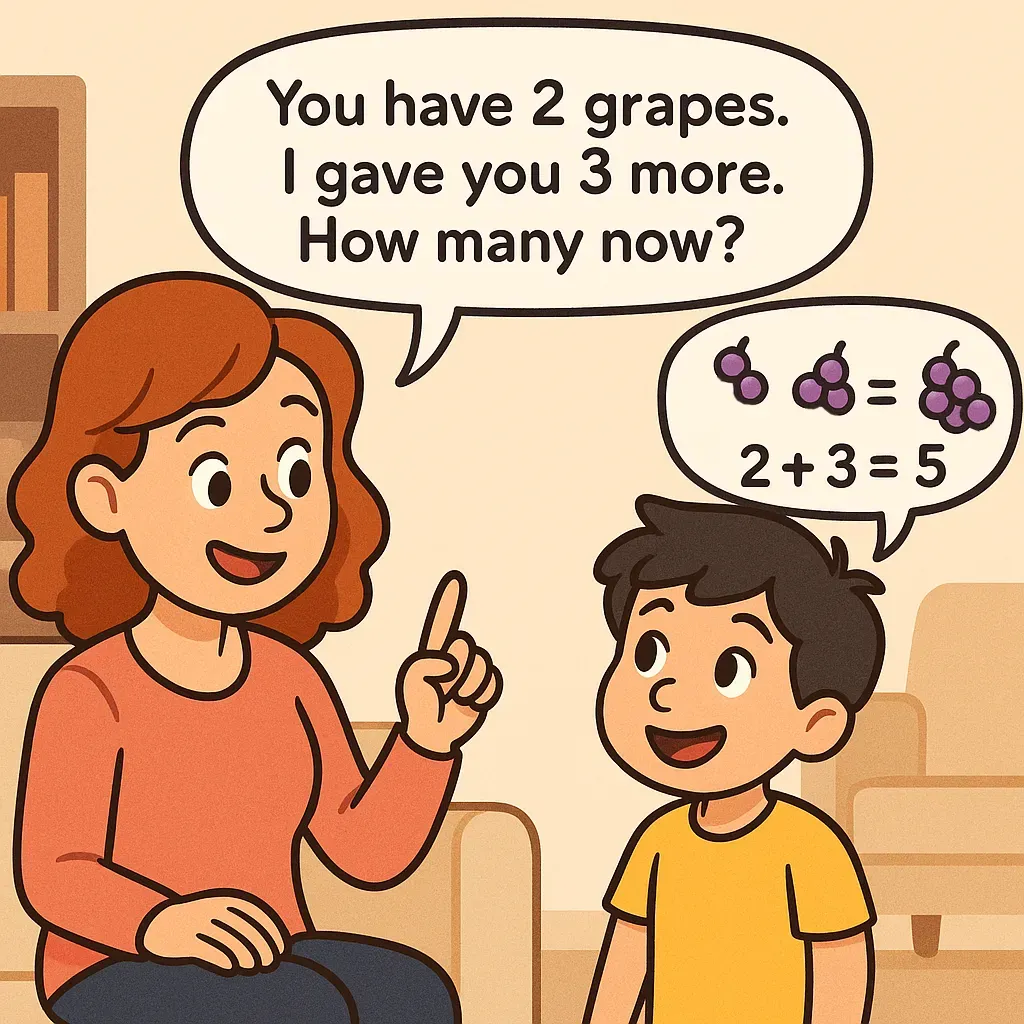From Counting to Adding: What Most Parents Miss
TL;DR
Counting and addition aren't the same. Most young children can recite numbers but don’t yet understand what those numbers mean. To move from counting to real addition, children need to develop cardinality (understanding the last number counted tells “how many”), and subitizing (instantly recognizing small quantities). Parents often miss this gap. By using visual strategies, playing with small groups of objects, and talking about numbers in everyday contexts, parents can help bridge this critical transition and build strong number sense in early learners.
Most parents are thrilled when their child learns to count out loud. We often assume that being able to recite “one, two, three…” means a child understands numbers and is ready to start adding them. But there’s an important step between counting and adding that many parents overlook. In fact, young children can often count to 10 or 20 by rote without truly grasping what those numbers represent. So, what are most parents missing? It turns out that kids need to develop a deeper understanding of quantity – and a skill called subitizing – before they can successfully move from counting to addition.
Counting vs. Understanding “How Many”
Just because a child can rattle off numbers in order doesn’t mean they understand how counting works. The real goal of early counting is to learn the cardinality principle: the idea that the last number stated when counting a set of objects tells you “how many” are in the set. Young children typically take months of practice to realize that, for example, counting five objects and saying “five” means there are actually five things in front of them. Research has shown that many parents overestimate their children’s grasp of this concept. In one study, most parents incorrectly assumed that their 3- or 4-year-olds already understood that the last number in a count denotes the total quantity – when in reality, many children that age hadn’t yet made that. It’s a common misconception: a child who can count to “five” doesn’t automatically know what “five” truly means.
Why is this understanding so important? Because without it, addition doesn’t make sense. If a child doesn’t fully understand that “five” means a set of five items, then asking them to combine sets (add) is just abstract number words. To help children move from counting to adding, parents should focus on linking numbers to actual quantities. Count familiar objects together (blocks, snacks, fingers) and emphasize that the final number in the count is the total: “1, 2, 3 – there are three cookies.” This helps reinforce what those number words really mean.
The Missing Skill: Subitizing
Beyond basic counting, another key skill bridges the gap to addition: subitizing. Subitizing is the ability to instantly recognize the number of objects in a small group without counting each one. For example, adults can usually look at four dots on a die and immediately know there are four, without needing to count “1-2-3-4.” Many young children can do this with 2 or 3 objects, even before they fully grasp counting. This skill is more than a neat trick – it’s an early form of visualizing quantity that lays the foundation for efficient adding.
When children subitize, they are essentially recognizing patterns and understanding quantity at a glance. This frees up mental energy. A child who immediately sees that one hand has five fingers, and the other hand has three, can quickly figure out “5 and 3 makes 8” without counting each finger. In contrast, a child who lacks subitizing might count “1-2-3-4-5…” every time. Encouraging subitizing can be as simple as playing dice or domino games, using dot cards, or asking “How many?” when shown small groups of objects briefly. It helps children move away from counting one-by-one and towards seeing the relationships between numbers – a critical step for addition.

Talking About Numbers (Meaningfully)
Another often-missed factor is how we talk about numbers with young children. Simply drilling counting sequences or asking “What’s 2+3?” isn’t as effective as weaving numbers into everyday life. Research suggests that some types of parent number talk count more than others when it comes to developing early math skills. In one longitudinal study, children whose parents regularly pointed out and discussed numbers in context – for instance, “You have three apples, let’s add two more” or “I see four toy cars on the floor” – had a much stronger grasp of cardinality and basic addition later on. Parents who focused only on counting routines (“Let’s count to ten!” without referencing objects) saw less benefit. The takeaway: make numbers meaningful. Talk about how many objects you see, involve your child in simple adding during daily tasks (“We have two cookies, and there are two of us – will we each get one?”), and use number words in concrete, relatable ways.
By enriching “number talk” in these ways, you’re helping your child connect the verbal counting routine to actual quantities and relationships. They learn that numbers aren’t just an abstract sequence you rattle off – numbers describe real things in their world. This kind of understanding is exactly what children need in order to progress from counting to true addition.
Bridging Counting and Adding
So what most parents miss is not a fancy curriculum or an advanced concept, but these foundational understandings of quantity and number sense.
- First, children must realize what numbers mean (that five is the whole hand you just counted, not just the word that comes after four).
- Next, they benefit from practicing seeing quantities through subitizing, rather than always counting by ones.
- And all along, they need rich, meaningful exposure to numbers in everyday life, not just in isolation or drill.
When these pieces are in place, children can start to do what we adults consider “addition” – often naturally. They will begin to recognize, for example, that if you have two toys and get two more, now you have four (without needing to count all four from scratch). They start “counting on” or using intuitive strategies because they understand the quantities involved.

As a parent, you can foster this development by engaging in simple activities:
- Count objects and talk about the total.
- play visual games with small quantities, encourage your child to instantly recognize familiar groupings (“How many dots are on this card?”), and keep highlighting numbers in context.
- Help them see the same number in different orientations (for e.g. 4 organised as 4 points of a square vs 4 organised as 3 and 1).
By doing so, you fill in the crucial gap between counting and adding. Your child learns that numbers are not just words to recite – they are amounts that can be combined, separated, and compared. With that understanding, addition (and subtraction) become a lot more meaningful and fun.
Children who receive this kind of support tend to progress more smoothly in math. They don’t get stuck counting on their fingers forever or feeling that math is just memorizing facts. Instead, they develop true number sense: an intuition for how numbers work. And it all starts with recognizing what we parents might have missed: that counting is only the beginning. It’s the understanding behind the counting – and some playful practice with real quantities – that really counts in building a young child’s math foundation.
FAQ: From Counting to Adding
Q: My child can count to 20. Why can’t they answer “What is 2 + 3?”
A: Rote counting doesn’t mean they understand quantity. They may be reciting number words without grasping what “2” or “3” actually represent. Before they can add, they need to understand cardinality—that the final number in a count tells how many items there are.
Q: What is cardinality, and why is it important?
A: Cardinality is knowing that the last number in a count equals the total quantity. Without this, children might count correctly but still not know how many objects are in the group. It’s a foundational skill for addition and all further math.
Q: What’s subitizing, and how does it help with addition?
A:Subitizing is the ability to quickly recognize small quantities without counting (like “seeing” four dots on a die). It builds visual number sense and helps kids move from one-by-one counting to understanding number combinations more intuitively.
Q: How can I tell if my child is ready to learn addition?
A: If they understand that counting leads to a total (“1, 2, 3… There are 3!”) and can combine small sets of objects meaningfully, they’re ready. You might also notice them using their fingers or beginning to "count on" from a number—both are good signs.
Q: Should I stop my child from counting on fingers?
A: No! Finger counting is developmentally appropriate and can support learning. It helps children represent quantities visually and tactilely, especially in early kindergarten. Over time, they’ll develop more efficient strategies—but fingers are a great starting tool.
Q: How can I support my child’s move from counting to adding?
A: Play games with small objects, encourage “how many?” questions, talk about combining groups in daily life, and practice meaningful number talk. Focus on understanding, not just speed or memorization.
References
- Fluck, M., Linnell, M., & Holgate, M. (2005). Does Counting Count for 3- to 4-Year-Olds? Parental Assumptions about Preschool Children’s Understanding of Counting and Cardinality.Social Development, 14(3), 496–513.
- Gunderson, E. A., & Levine, S. C. (2011). Some types of parent number talk count more than others: Relations between parents’ input and children’s cardinal-number knowledge.Developmental Science, 14(5), 1021–1032.
- Clements, D. H. (2021). Subitizing: What is it? Why teach it?Teaching Children Mathematics, 114(12), 984–991. (Original work published 1999 in Teaching Children Mathematics)

